Imagine you’ve crafted a fantastic headline that gets someone to notice your page in search results; that’s a win, but it’s only the first step. Now, the meta description, that small block of text (usually 1 to 2 lines) right under the blue clickable link, has to seal the deal by convincing them to actually visit your site.
Think of it as a mini sales message: if it’s too generic or unclear, even the best rankings won’t bring in visitors. But when it’s targeted and specific, it attracts the people who truly need what you offer, while politely steering away those who don’t. It’s like a sign outside a shop that says exactly what’s inside, helping the right customers feel welcomed and excited to step in, without wasting anyone’s time.
Table of Contents
The Real Job of a Meta Description
A powerful meta description doesn’t magically improve where your page shows up in search rankings. That’s handled by other SEO factors. Instead, its main role is to increase your click-through rate (CTR), which is simply the percentage of people who see your page in results and decide to click on it. You can start optimizing this today without needing advanced skills.
By using those couple of lines to give a sneak peek of the real value on your page, you draw in visitors who are a good fit, meaning they’re more likely to stay and explore. At the same time, it filters out mismatched searchers who might click but leave quickly (that’s called pogo-sticking, which can hurt your site’s performance). Overall, this smart approach boosts your traffic from existing rankings, all without having to create brand-new content.
- Not a ranking factor, a click factor – It influences clicks, not positions.
- Previews value so the right visitor selects you – Gives a taste of what’s inside to attract ideal readers.
- Lowers pogo sticking and improves engagement – Keeps bounce rates low by setting accurate expectations, leading to longer visits.
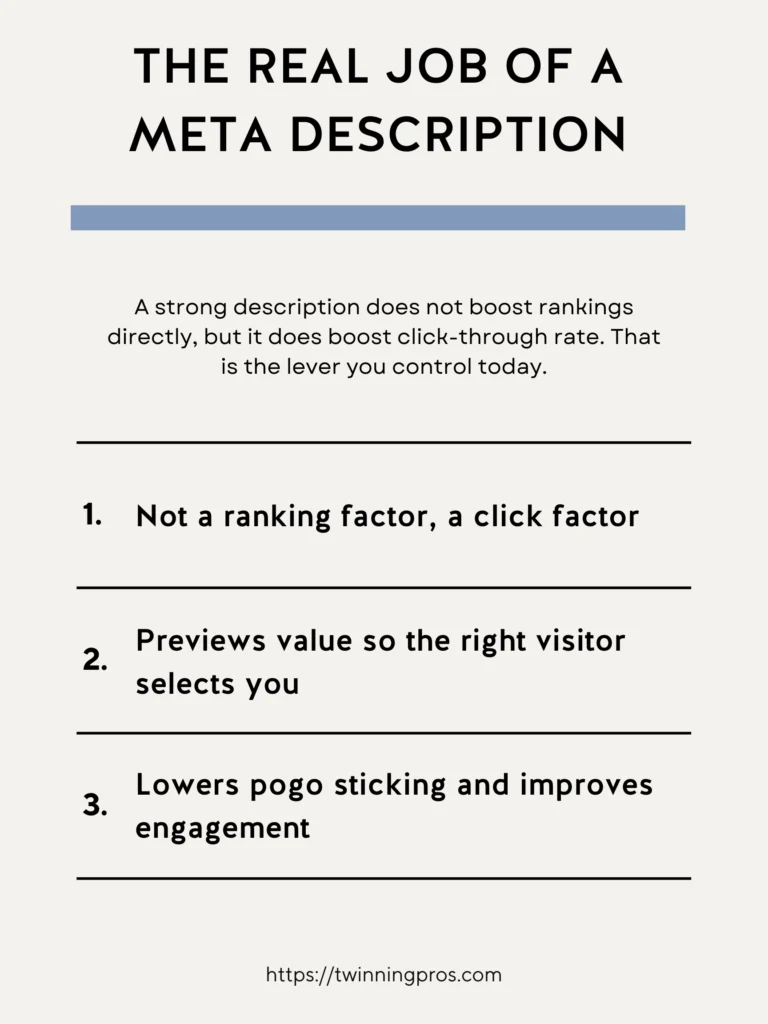
The 140 to 155 Character Sweet Spot for meta descriptions
Keeping your meta description to a specific length encourages you to be clear and focused, much like writing a tweet where every word counts. Aim for around 140 to 155 characters. That’s typically one solid sentence or two shorter ones that fit nicely in search results without getting cut off.
Start strong by highlighting the main benefit, like what the reader will gain or learn, then add a single supporting detail such as how long it takes, some proof of results, or a quick overview of the process. Wrap it up with a gentle nudge toward action, like inviting them to explore more. This structure keeps things punchy and effective, avoiding rambling that might turn off beginners scanning quickly.
- Target 140 to 155 characters – Ensures it displays fully on most devices.
- Benefit first, then one specific detail – Hooks with value, then adds credibility.
- End with a soft CTA – A subtle call like “Get started” encourages the click without pressure.
Example, how to meta description:
“Verify your site in Search Console with step by step screenshots, fix common errors fast, and start tracking results today.” – This guides beginners through a process with visuals and quick wins.
Example, local service meta description:
“Window cleaning in Covington, pure water shine, transparent pricing, and easy online booking. See photos and schedule today.” – Targets locals with clear perks and an simple next step.
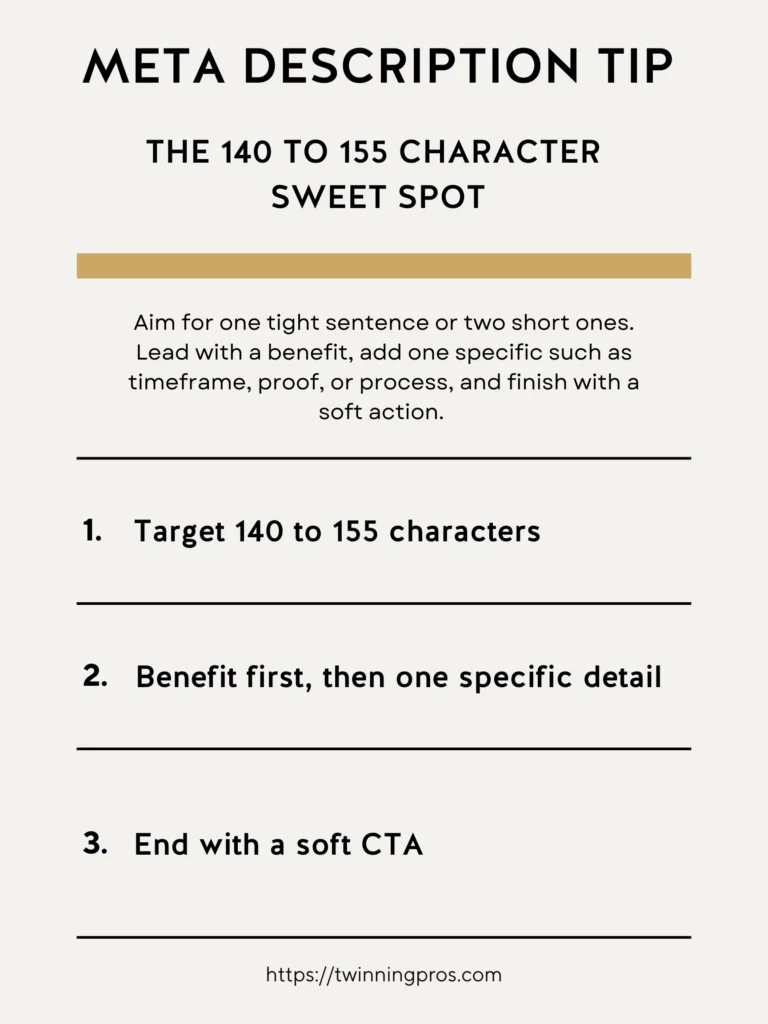
The Benefit + Curiosity Formula
A reliable way to craft meta descriptions is to follow a basic pattern that balances helpfulness with just enough intrigue to spark interest, all without over-the-top hype. You’re essentially talking directly to the reader, addressing their situation or need, promising a positive result, backing it up with a concrete detail, and suggesting a small, easy action. This combination of benefit (what they get) and curiosity (wanting to know more) is perfect for getting meaningful clicks from people who will actually benefit from your content.
- {Audience or Problem} → {Benefit or Outcome} + {Specific} + {Action} – A simple flow to structure your text.
- “Own a salon? Get a simple SEO plan to rank locally, attract high value bookings, and track results. Download the free 7 step checklist.” – Speaks to business owners with a tailored plan and free resource.
- “New to schema? Add it in minutes with copy paste snippets and screenshots. Start with our quick guide.” – Eases beginners into technical stuff with easy tools.
The benefit earns attention – It shows immediate value to draw them in.
The specific builds credibility – Details like steps or examples make it feel trustworthy.
The action tells them what to do next – Guides without overwhelming.
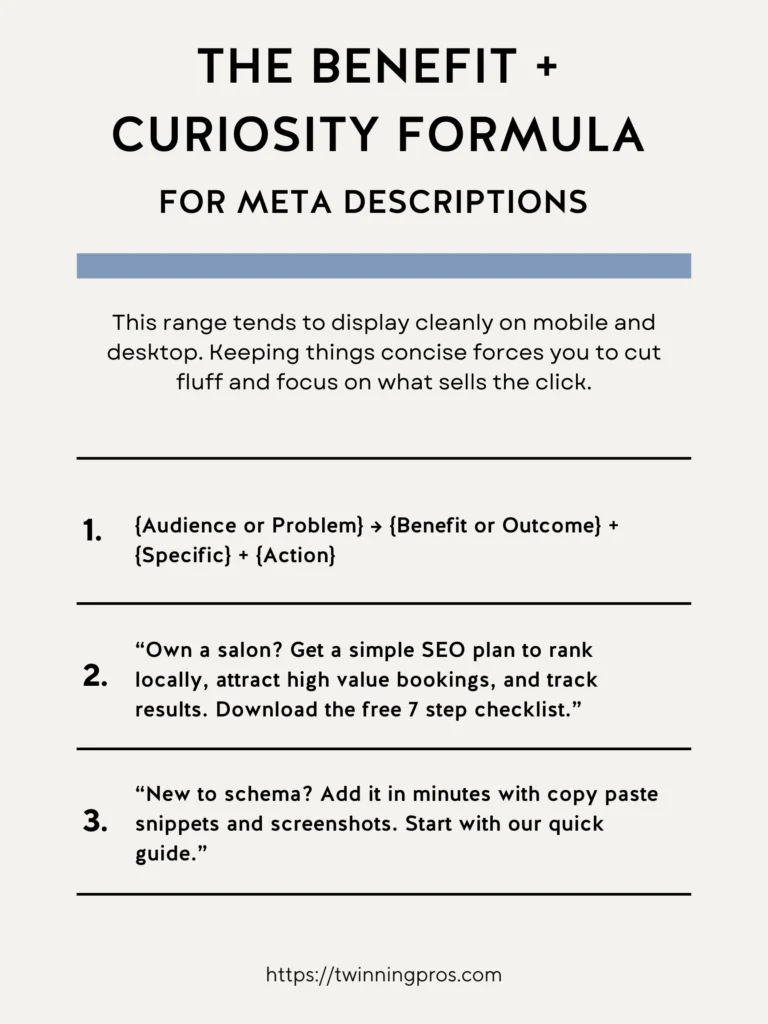
10 Plug and Play Meta Description Templates
Templates are like ready-made outlines that take the stress out of writing, especially for SEO newcomers. They give you a starting point so you can focus on customizing rather than staring at a blank page. These 10 options are versatile starters; just plug in your page’s main topic, audience, or key details, and adjust the wording to sound like your natural voice. They’re designed to be straightforward and effective, helping you create descriptions quickly that highlight value and encourage clicks.
- “Learn {Primary Topic} with a simple, step by step guide. See examples and avoid common mistakes.” – Great for educational content.
- “Struggling with {Problem}? Use this {Checklist or Template} to {Outcome} in {Timeframe}.” – Addresses pain points with solutions.
- “{Audience}: Get a {Number} step plan to {Benefit}. Download the free worksheet.” – Targets specific groups.
- “See real examples of {Topic} that {Proof or Outcome}. Start with our formulas.” – Uses evidence to build interest.
- “{Topic} made easy, clear steps, screenshots, and quick wins for busy teams.” – Emphasizes simplicity.
- “Everything you need to {Outcome}, no fluff, only the steps that work.” – Promises efficiency.
- “Stop guessing about {Topic}. Use our tested approach to get predictable results.” – Builds confidence.
- “Avoid {Common Mistake}. Follow our {Topic} checklist to {Outcome}.” – Focuses on prevention.
- “From {Starting Point} to {Outcome}, the practical playbook for {Audience}.” – Shows progression.
- “Ready to {Outcome}? Grab the templates and ship your first win today.” – Motivates action.
Pro tip: write three versions. One benefit first. One pain first. One proof first. Then choose the cleanest. – Testing options helps find what fits best.
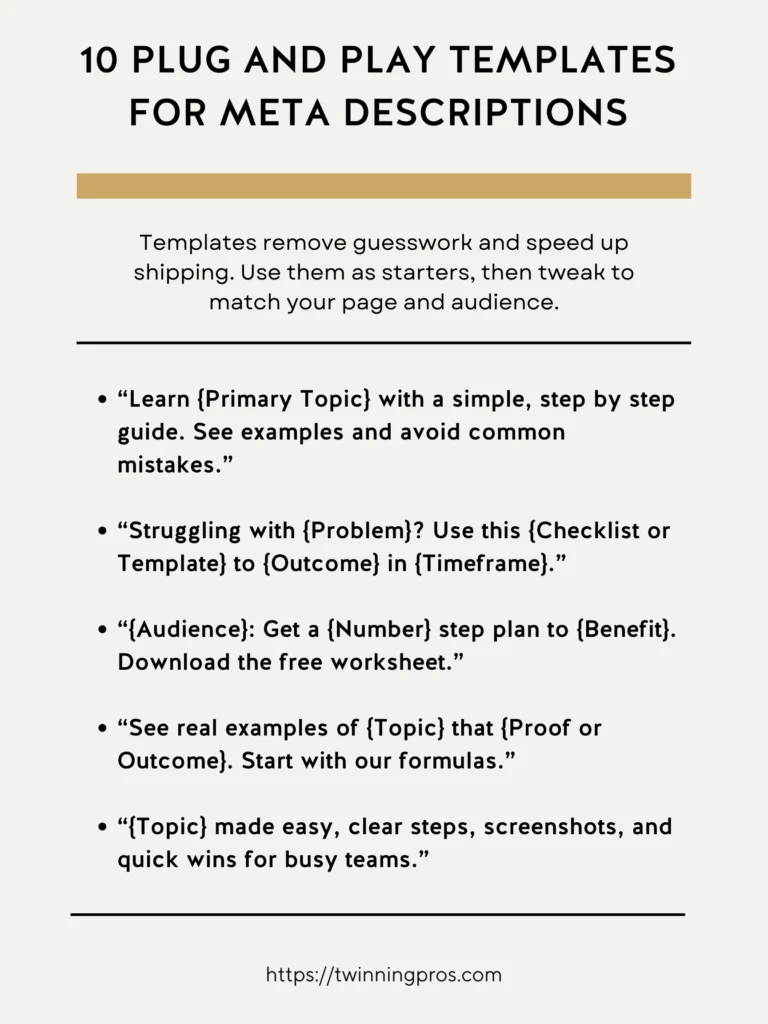
How to Test and Improve Meta Descriptions
The real magic happens when you treat your meta descriptions like ongoing experiments. Small changes can lead to noticeable improvements over time. Think of them as ads you refine based on performance. Use free tools to spot pages that show up a lot in searches (high impressions) but don’t get many clicks (low CTR), then tweak the description to make the promise clearer or more appealing. Always update the title tag and meta description together for a unified message. This iterative approach is beginner-friendly and can boost your results without major overhauls.
- Check CTR in Google Search Console and find low CTR pages at similar positions – Identifies quick-fix opportunities.
- Iterate monthly and refresh title + description together – Keeps things fresh.
- Try benefit first vs pain first and add numbers like steps, timeframe, or results – Numbers add specificity.
- Match the promise on page and place the payoff above the fold – Ensures content delivers immediately, visible without scrolling.
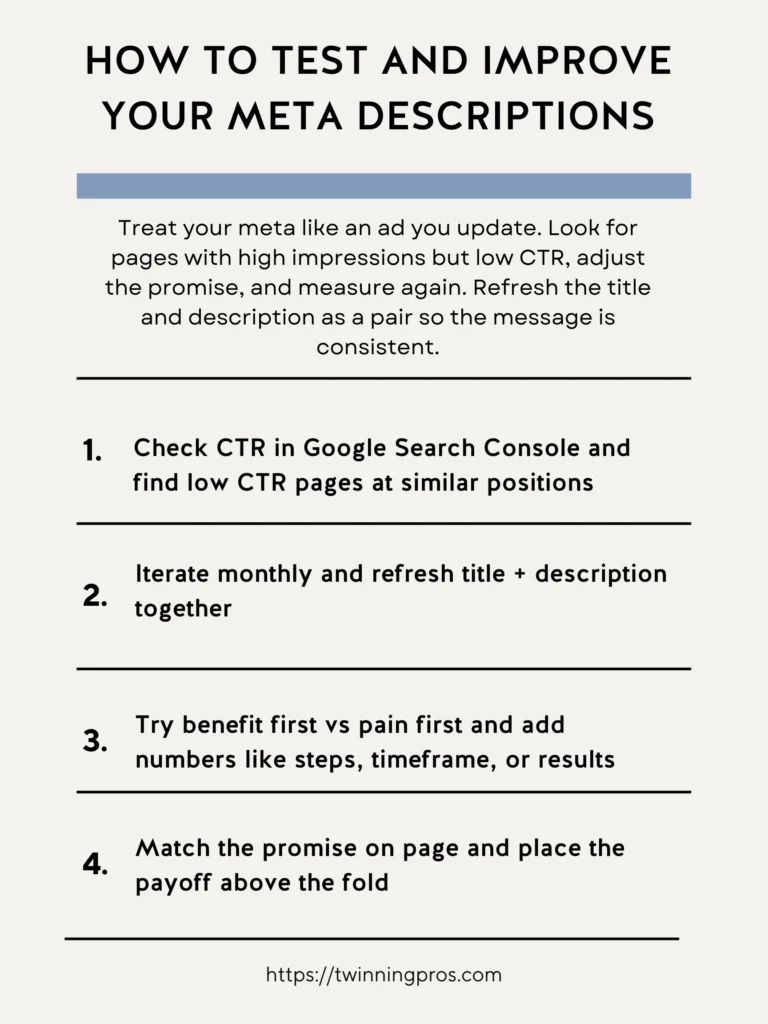
Common Mistakes to Drop
Even with good intentions, certain habits can sabotage your efforts and make strong rankings less effective. The goal is to keep things simple, honest, and focused. Stick to one main idea, use plain language, and make sure what you promise is exactly what the page provides right away. Avoiding these pitfalls will help your descriptions feel more genuine and perform better for attracting the right visitors.
- Two ideas jammed into one description – Overloads and confuses.
- Keyword stuffing or repeating the same phrase twice – Looks spammy.
- Vague claims like “ultimate” or “best” with no detail – Lacks credibility.
- Copy pasting the same description across pages – Misses uniqueness.
- Mismatch between snippet and page, such as promising “pricing examples” and hiding them – Leads to frustration and bounces.
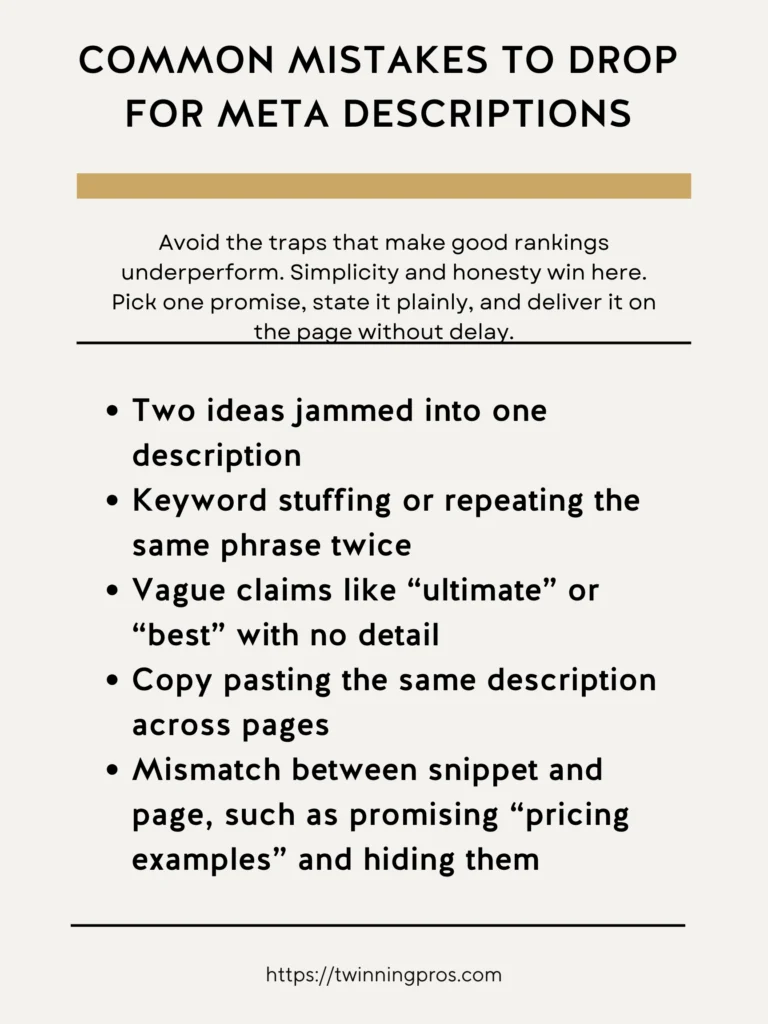
Quick Implementation Checklist
This handy checklist is like a quick safety net. It ensures every meta description you create is polished and ready to perform. As a beginner, running through it before publishing takes just a minute or two but catches issues that could otherwise reduce clicks. It promotes consistency, so your site’s search snippets always come across as clear, credible, and inviting.
- 140 to 155 characters – Fits perfectly in results.
- Benefit up front and one clear idea – Hooks immediately.
- One specific that adds credibility – Like a number or example.
- Natural language with minimal repetition – Sounds human.
- Matches the on page promise – Aligns expectations.
- Light CTA such as “See steps,” “Download,” or “Book” – Gentle nudge.
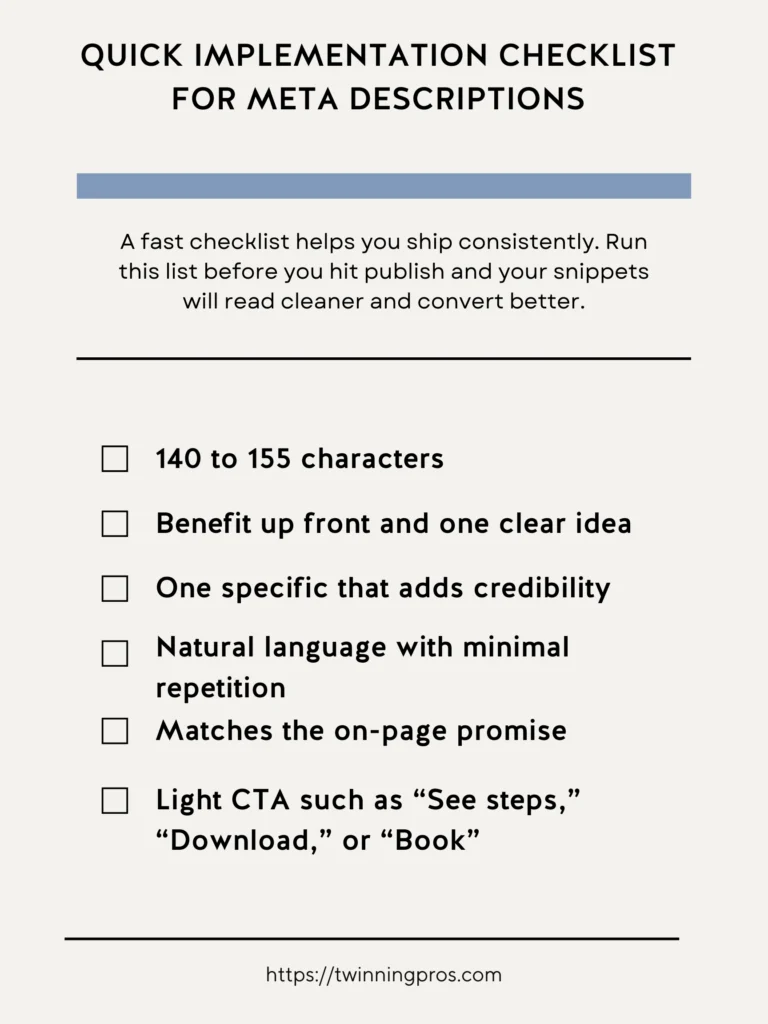
Examples You Can Tweak
To make this even easier, here are a few pre-written examples you can adapt directly for your own pages. Just replace the placeholders with your specific details, like your topic or target audience, and keep the straightforward, helpful tone. These are designed for common scenarios, so they’re a great starting point to practice without starting from scratch.
- “Write title tags that lift CTR with 10 copy ready formulas and before or after examples. See what to copy and what to avoid.” – For SEO tips.
- “Local SEO checklist for service businesses. Optimize GBP, fix citations, and build steady reviews. Download the worksheet.” – For local pros.
- “Internal linking map for topic clusters. Templates and anchor examples inside.” – For site structure advice.
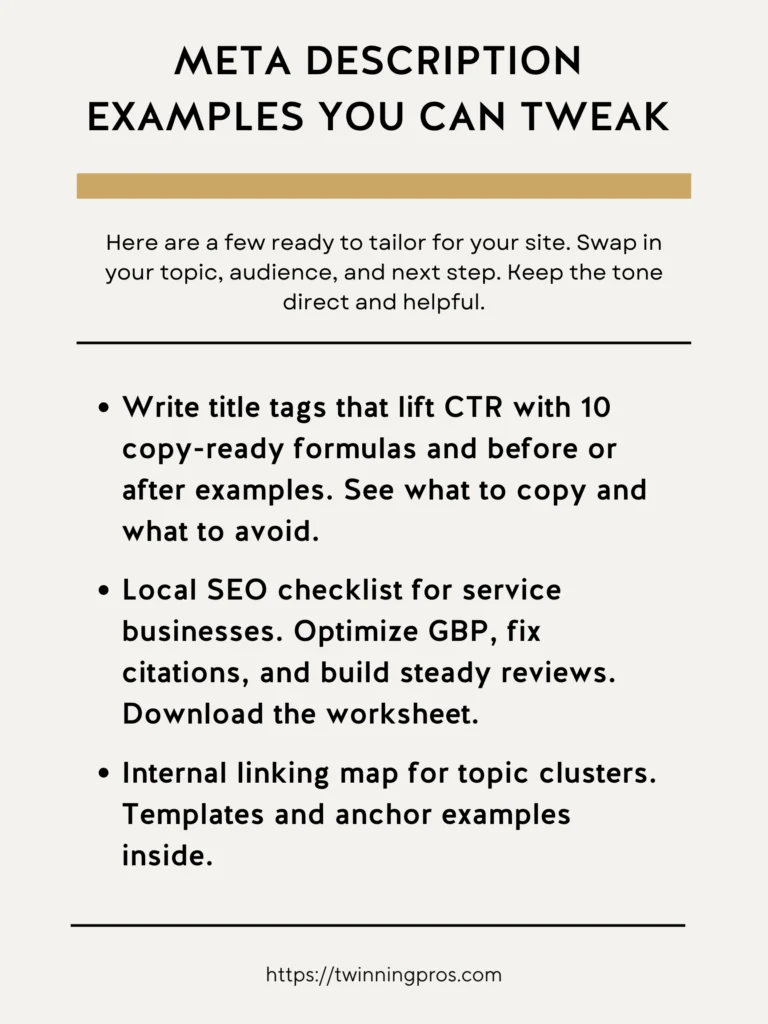
Final Thoughts
A great meta description earns the second yes. The title wins the glance. The description turns interest into intent by promising a clear benefit in two short lines. Lead with the outcome your reader wants, add one proof point or detail, and invite one simple action. Treat descriptions like ads you update, not labels you set and forget. When your snippet reads like a mini offer and your page fulfills the promise, clicks rise and bounce falls because the right people know exactly what they are getting.
Here is a simple playbook. Write one benefit first version, one proof first version, and one curiosity led version for each key page. Keep it to roughly 150 to 160 characters, use the primary topic once, and mirror the page’s first section so the handoff feels seamless. Review Search Console by page. If impressions are healthy and CTR lags, swap in the strongest variant and retest.
Next Steps
As you’ve seen throughout this beginner’s guide to SEO fundamentals, small, consistent tweaks can make a massive difference in how search engines and visitors perceive your site. But remember, true success comes from a holistic approach tailored to your unique business. If you’re ready to take your SEO to the next level, check out our professional SEO services, where we handle everything from keyword research to on-page optimization to help you rank higher and attract more customers.
No matter where you are on your SEO journey, whether you’re just starting or already seeing some traction, it’s essential to have your website professionally audited at least twice a year to uncover hidden issues and keep things running smoothly; our comprehensive SEO Audit dives deep into your site’s performance, providing actionable insights without the overwhelm.
And if you want to build these skills yourself, enroll in our beginner-friendly course, The SEO CEO, I’m Tabatha, an SEO expert with years of hands-on experience, and after reviewing countless beginner courses that gloss over the details and lack real-world examples, I designed this in-depth program with plain-English lessons, step-by-step templates, and live walkthroughs so you can start applying these fixes today, not after wading through vague theory. Let’s turn your website into a traffic magnet; get started now and watch your online presence grow.
Meta description FAQs
What is a meta description and where does it appear?
It’s an HTML tag (<meta name="description" content="…">) that summarizes the page. Google usually builds the SERP snippet from on-page text, but may use your meta description if it’s a better summary.
There’s no guarantee it will be shown.
How long should a meta description be?
There’s no fixed character limit. Google truncates snippets as needed to fit device width, so lead with the most important info in the first sentence.
Many SEOs target ~140–155 chars for design reasons, but clarity matters more than length.
Do meta descriptions affect rankings?
Not directly. Their job is to earn the click by setting the expectation. Clear, specific descriptions can improve CTR at a given rank.
Google treats them as candidates for snippets, not ranking signals.
When does Google rewrite my description?
Often, snippets are query-dependent. If your tag is missing, duplicated, vague, or off-topic, Google will pull text from the page that better matches the searcher’s query.
What makes a good meta description?
– State the topic and outcome in plain language.
– Add specifics (features, audience, price, location, date) as relevant.
– Use natural language; avoid keyword lists.
– Keep each page’s description unique.
– Google’s doc explicitly recommends unique, informative descriptions that consolidate key details users care about.
Should my description repeat the title?
No, it should complement it. The title sells the click; the description previews what’s inside (benefit + specifics). If they’re too similar, Google is more likely to ignore your tag and assemble a snippet from body text.
How do I handle e-commerce/product pages?
Surface the details users scan for (price, availability, model, key differentiator) in one tight sentence. Google’s guidance explicitly calls out using the description to bring scattered details together.
What about large sites; Do I need a unique description for every URL?
Prioritize critical URLs (home, categories, top traffic pages). Unique is best, but at scale, you can programmatically generate descriptive tags from on-page fields (category, filters, location, etc.). Avoid site-wide boilerplate.
Can I control how much of my text Google shows in the snippet?
Partially. Use robots meta directives like max-snippet:[number] to cap snippet length, or nosnippet/data-nosnippet to exclude all or parts of the page from snippets. Use sparingly; these settings also affect Discover/Images and AI Overviews.
Should I include keywords?
Yes, use them naturally and in context. Snippets bold words that match the query, which can lift perceived relevance. Avoid stuffing or comma-separated keyword lists; they get ignored.
How do I troubleshoot low CTR despite good positions?
Audit pages with high impressions/low CTR in Search Console. Tighten the opening phrase to match intent, add a specific benefit or data point, and remove filler. Also, check that your on-page copy provides text Google can use to build better, query-matching snippets.
Can I hide sensitive text from snippets but keep the page indexed?
Yes. Wrap the sensitive fragment in an element with data-nosnippet, or use max-snippet:0 (equivalent to nosnippet) at page level. But note that this suppresses your text snippet and may reduce visibility.
What are some meta description templates I can use?
– Learn [Topic] with step-by-step examples and free template.”
– Compare [Product] options: prices, pros/cons, and picks for [Audience].”
– Plan your [Trip/City] map, costs, 1–7-day itineraries, and local tips.”
SEO for Beginners
Learn from the SEO Strategist who has 75+ first page Google rankings under her belt.
We’re marketing nerds and business strategists that have generated millions of dollars in client revenue. We're sharing the systems and strategies to help your growing business with marketing that actually converts.
We're Tiffany + Tabatha

Comments